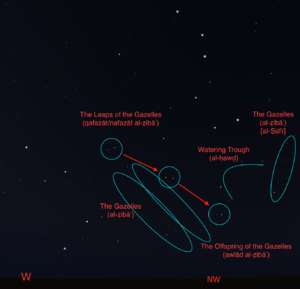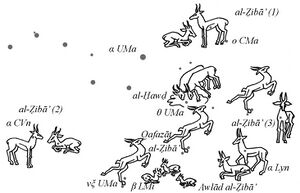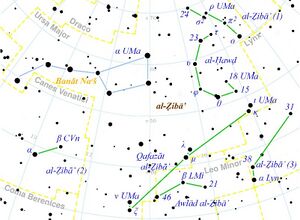al-Ẓibā’ (الظباء)
The Arabic term means "Gazelle" and designates a group of asterisms (some single star-asterisms forming a herd) in the ancient indigenous Arabic sky culture. Laffitte (2012) gives a long list of identifications of its stars based upon different sources from different centuries and authors. Adams (2018) suggests to be more careful in separating different states of the constellation because different authors may have shifted the name labels over the course of time.
Etymology and History
Al Thiba (σ1σ2 UMa : 5,15 & 3,25) according to Laffitte (2024): Borrowed at the end of the 20th century, this name is justified by the fact that these stars constitute, in al-Ṣūfī, one of the subgroups of al-Ẓibā', “Gazelles” of the Ancient Arabs, which also groups other stars from Ursa Major (UMa) but also from nearby constellations, Leo Minor (LMi) and Lynx (Lyn). The second group of al-Ẓibā‘ is made up of α and β CVn, the third by α and 31-32 Lyn, while the stars of the Little Lion, namely 46, 21 and β LMi are Awlād al-Ẓibā’, ‘the Little Gazelles’, Ibn Qutayba.
- al-Ṣūfī (10th c.) Al-Qazwīnī (13th c.). ‘El-dhibâ’
- Ideler (18xx), ‘Al Ṭhibā’’
- Allen (1899) identifies Al Thiba I-VII p/ aπφρσ1σ2d UMa
- Rhoads (1971) identifies p/σ1σ2
al-Ẓibā’ in Danielle Adams, Rain Stars Set, Lunar Stations Rise, 2018, p. 102.
"Both Ibn Qutayba and al-Marzūqī report that the Gazelles themselves [al-ẓibāʾ] were represented by an elongated line of stars located below their Leaps, with the Offspring of the Gazelles (awlād al-ẓibāʾ) as the very faint stars that lie between the Gazelles and their Leaps (Ibn Qutayba 1956, 66-67; al-Marzūqī 1914, 2:374). According to al-Ṣūfī, the Gazelles leapt away from the Coarse Tail Hair of the Lion and arrived at the Watering Trough (al-ḥawḍ), which is a semicircle of stars located near the Third Leap that the other authors also describe (1981, 33; Ibn Qutayba 1956, 67; al-Marzūqī 1914, 2:374-375). Al-Ṣūfī locates the line of Gazelles in a different location near the Watering Trough, with their Offspring again being the many faint stars located nearby and extending toward the Extended Forearm of the Lion (dhirāʿ al-asad al-mabsūṭa; 1981, 33, 34)."
al-Ẓibā’ in Roland Laffitte, Le ciel des Arabes, 2012, pp. 112-113.
| ο2ρπ2σ2d UMa +αβ CVn + α/31 Lyn | ||||
| Arabic | French | English | Author | |
| al-Ẓibā’ | les Gazelles | the Gazelles | Qutayba | |
| α Lyn | Ğanūbī ’l-Ḍibā’ [p/ al-Ẓibā’] | l’Australe des Gazelles | the southern one of the Gazelles | Miṣrī |
| 31 Lyn | Mutaq. al-Ḍibā’ [p/ al-Ẓibā’] | l’Antérieure des Gazelles | the front one of the Gazelles | Miṣrī |
| 38 Lyn | Šamālī ’l-Ḍibā’
[en fait : al-Ẓibā’] |
la Boréale des Hyènes
[en fait : les Gazelles] |
the northern one of of the Hyena | Miṣrī |
| 46, 21+β LMi | ||||
| Awlād al-Ẓibā’ | les Petits des Gazelles | the small one of the Gazelles | Qutayba | |
| Awlād al-Ġizlān | idem | Ṣūfī | ||
| τhυφθef UMa | ||||
| al-Ḥawḍ | l’Abreuvoir | the Water Trough | Qutayba | |
| al-ᶜUnq | l’Assemblée | the Meeting | Qutayba | |
| ικλμνξ UMa | ||||
| Qafazāt al-Ẓibā’ | les Sauts | the Jumps | Qutayba | |
| al-Qafazāt | les Sauts [des Gazelles] | the Jumps (of the Gazelles) | Qutayba | |
| Qafazāt al-Ġizlān | les Sauts des Gazelles | The Jumps of the Gazelles | Ṣūfī | |
| al-Qawāfiz | les Bondissantes | the Bouncings | Marzūqī | |
| Baqarāt al-Ẓibā’ | les Gazelles femelles | the female Gazelles | Fāris | |
| νξ UMa | al-Qafazat al-Ūlā | le 1er Saut | First Jump | Ṣūfī |
| λμ UMa | al-Qafazat al-Ṯāniyya | le 2nd Saut | Second Jump | Ṣūfī |
| ικ UMa | al-Qafazat al-Ṯāliṯa | le 3ème Saut | Third Jump | Ṣūfī |
| ι UMa | Šamālī ’l-Qafazat al-Ūlā
[en fait : al-Ṯāliṯa] |
la Boréale du 1er Saut
[en fait : le 3ème] |
the northern one of the first jump | Miṣrī |
| κ UMa | Ğanūbī ’l-Qafazat al-Ūlā
[en fait : al-Ṯāliṯa] |
l’Australe du Premier Saut
[en fait : le 3ème] |
the southern one of the first jump | Miṣrī |
| λ UMa | [Šamālī] ’l-Q. al-Ṯāniyya | [la Boréale] du 2nd Saut | (the northern one) of the second jump | Miṣrī |
| μ UMa | Ğanūbī ’l-Q al-Ṯāniyya | l’Australe du 2nd Saut | the southern one of the second jump | Miṣrī |
| ξ UMa | Ğanūbī ’l-Q. al-Ṯāliṯa
[en fait : al- Ūlā] |
l’Australe du 3ème Saut
[en fait le 1er] |
the southern one of the third jump | Miṣrī |
NB : Miṣrī is Nağm al-Dīn al- Miṣrī (XIVth c.), see Ğadwal maṭāliᶜ al-kawākib wa-abᶜādihā wa-ğihatihi, or "Tables of right ascensions of the stars and their declinations", accompanied by their signs [+ or -] is one of the tables in the book Kitāb fī l-ālāt al-falakiyya by Nağm al-Dīn al-Miṣrī, between 1325 and 1340. It is edited and partially translated by ms. Oxford, Bodeliean Library, Marsh 672, fol. 148v-151r, in CHARRETTE, François, Mathematical Intrumentation in Fourteenth-Century Egypt and SyriaB►, 2003, p. 360-370.
al-Ẓibā’ in Paul Kunitzsch, Untersuchungen zur Sternnomenklatur, 1961.
* 21a. awlād aẓ-Ẓibā’, p. 39:
„die Jungen der Gazellen“. Ibn Qutayba 67, 1 (bei den unter Mondstation 14 mitbehandelten Sternen): kawākib ṣiġār fī-mā bayna ẓ-ẓibā’ wa-l-qafazāt „kleine Sterne zwischen aẓ-ẓibā’ [nr. 329] und al-qafazāt [nr. 211a]“. Ṣūfī 34, 1f. und 18‒20 zählt besonders den 5. bis 8. externen Stern im ptolemäischen Bildes Großer Bär = Fl. 10 Leonis Minoris; IX, 115; VIII, 245; Fl. 31 Lyncis hierzu, sowie all die zahllosen Sterne, die schwächer sind als Größe sechs und die Ptolemäus nicht angeführt hat.
English: 'the young of the gazelles’. Ibn Qutayba 67, 1 (for the stars treated under lunar station 14): kawākib ṣiġār fī-mā bayna ẓ-ẓibā‘ wa-l-qafazāt “small stars between aẓ-ẓibā” [no. 329] and al-qafazāt [no. 211a]’. Ṣūfī 34, 1f. and 18-20 counts especially the 5th to 8th external star in the Ptolemaic image Great Bear = Fl. 10 Leonis Minoris; IX, 115; VIII, 245; Fl. 31 Lyncis, as well as all the countless stars that are fainter than magnitude six and that Prolemy did not mention.
* 329. aẓ-Ẓibā’, p. 120:
„die Gazellen“. Ibn Qutayba 66, 11 (bei den unter Mondstation 14 mitbehandelten Sternen): kawākib mustaṭīla asfal min qafazāt aẓ-ẓibā’ „der Länge nach angeordnete Sterne unterhalb von qafazāt aẓ-ẓibā’ [= ικλμνξ Ursa Majoris]“; Ṣūfī 33,7 identifiziert aẓ-ẓibā’ mit den Sternen auf Brauen, Augen, Ohren und Maul des ptolemäischen Bildes Großer Bär (d. h. der 4., 5., 2., 3., 6. und 1. Stern) = ρο2Aπ2σ2dο Ursae Majoris, wozu er 33, 19‒34, 2 noch den 8., 3., und 4. externen des Großen Bären = Fl. 31, 40 (α), 38 Lyncis hinzunimmt. Nur die letzteren drei stimmen mit der anwā’ Definition „unterhalb von qafazāt aẓ-ẓibā’” überein.
English: ‘the gazelles’. Ibn Qutayba 66, 11 (for the stars treated under lunar station 14): kawākib mustaṭīla asfal min qafazāt aẓ-ẓibā‘ “stars arranged lengthwise below qafazāt aẓ-ẓibā” [= ικλμνξ Ursa Majoris]’; Ṣūfī 33,7 identifies aẓ-ẓibā with the stars on the brows, eyes, ears and mouth of the Ptolemaic image Great Bear (i.e. the 4th, 5th, 2nd, 3rd, 6th and 1st stars). i.e. the 4th, 5th, 2nd, 3rd, 6th and 1st star) = ρο2Aπ2σ2dο Ursae Majoris, to which he adds 33, 19-34, 2 the 8th, 3rd and 4th exterior of the Great Bear = Fl. 31, 40 (α), 38 Lynis. Only the latter three agree with the anwā‘ definition “below qafazāt aẓ-ẓibā”’.
Mythology
IAU Working Group Star Names
The name was discussed and approved by the IAU WGSN in 202x. As this star is already named ..., the WGSN chose ... (not to apply/ to apply the name to a neighbouring star/ to ...) in the IAU-CSN.







